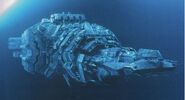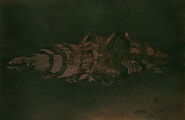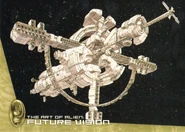The USM Auriga, registration number USMRV118,[1] was a top-secret scientific research ship in service with the United Systems Military. It was notably where the USM project to recreate the Xenomorph XX121 species, by cloning the deceased Ellen Ripley, reached its completion.
The ship was ultimately destroyed in 2381 when Annalee Call deliberately set it on a collision course with the Earth, in order to stop the Cloned Xenomorphs on board from spreading and jeopardizing the entire human race.
Overview
The USM Auriga was 12,000 feet in length and maintained a constant crew of forty-two enlisted soldiers under the command of General Martin Perez. The ship also housed a seven-personnel science team led by Dr. Mason Wren.[4] The ship was controlled by an artificial intelligence program, Father, which oversaw the ship's autopilot, life support and and personnel organization systems. The Auriga had a mess hall, sleeping quarters, recreation hall, numerous laboratories and several containment cells used to hold the Xenomorphs that were bred aboard the ship. The vessel also featured numerous maintenance areas, including a large waste tank at the bottom of the ship.[5]
History
The Auriga was commissioned in 2369.[1] By 2381, the ship was in orbit around Pluto during the final stages of the Xenomorph recreation project.[6] It was here that the ship rendezvoused with the Betty, a smuggling vessel delivering kidnapped civilians to be used as hosts for the Xenomorphs.
Following the escape of the Cloned Xenomorph specimens, Perez immediately gave orders to abandon ship. While several members of the crew successfully escaped in the Auriga's escape pods, a large part of the crew were killed or captured before they could get off the ship, including Perez and most of the science team. Father subsequently set a course for Earth, following standard operational protocols, where the ship would dock, almost certainly unleashing the Xenomorphs upon the planet. As a result, the surviving Betty crew members rerouted the ship to crash straight into the planet and ensure the destruction of the Aliens. The Auriga ultimately ploughed into an uninhabited region of Africa, completely destroying the ship and everything on board and causing an estimated $300 trillion worth of damage.[1]
Legacy
Knowledge of the Xenomorph experiments conducted on the Auriga was covered up, while the destruction of the ship itself was blamed on terrorists.[7] Nonetheless, the devastation caused by its impact with Earth, as well as a growing sense of dissatisfaction with the USM, eventually led to the collapse of the organization and the re-emergence of corporate entities such as Weyland-Yutani.
Behind the Scenes
The original design for the Auriga by Nigel Phelps incorporated an unusual vertical, cross-shaped midsection, designed to mimic a Christian crucifix as a reference to the film's theme of resurrection.[8] However, the unusual shape led to problems with scaling the model on camera, and also led to difficulties framing the tall shape in the film's 2.35:1 aspect ratio. Eventually the idea was scrapped and concept artists Jim Martin and Sylvain Despretz were tasked with redesigning the ship with a more traditional hull layout.[9] The final design was a mixture of the two men's efforts. The ribbed side panels located at the mid-point of the ship's hull were supposed to mimic the spindly fingers of a Facehugger.[9] In the novelization of the film, the Auriga is repeatedly described as a space station rather than a ship, likely tying in to the original, vertical design.[10]
The model used for filming was constructed from foam core and cardboard[9] and measured 12 feet from bow to stern.[11] Unlike many movie spacecraft models, which are constructed through "kitbashing" — that is, taking pieces from existing off-the-shelf models kits and trimming and assembling them to create a spacecraft design — the Auriga was built completely from scratch using custom-made components.[12] The myriad illuminated portholes on the ship's hull were created with fibre optic cables, the ends exposed to the outside, which were then illuminated to give the impression of on-board light.[13]
The ship's internal corridors were designed to mimic those of the Nostromo, whilst still feeling different; most notably, they utilize a similar hexagonal cross-section.[14] The ship's docking bay, where the Betty arrives near the start of the film, was modelled after a submarine pen, an idea proposed by Jean-Pierre Jeunet.[15] The miniature set was constructed to the same scale (1/32) as the Betty miniature, so the two could simply be filmed together instead of requiring expensive compositing at a later date.[12]

Amalgamated Dynamics, Inc.'s design and display room.
After filming on Alien Resurrection wrapped, some of the walls from the Auriga interior sets were taken by Amalgamated Dynamics, Inc. and used for the walls of their design and display room at their California studio.[16][17]
Trivia
- The name of the vessel, Auriga, means "chariot" in Latin.
- It is unclear why Ripley 8 and Call decided to crash the Auriga into Earth in such a potentially destructive manner. If they had the ability to reprogram the ship to speed up and crash, they must also have had the ability to change its course. They could have flown it into another planet in the Solar System, or even the Sun, which would have achieved the same aim with far less risk of collateral damage. It is never established in the film what damage is done by the Auriga exploding over Africa, let alone whether the continent is still inhabited (although, in the extended Special Edition of the film, Call remarks that she is directing the ship to an uninhabited sector). Even so, the damage created by a large spaceship flying into the planet at high speed would be wide-reaching and extreme; the size of the fireball seen would probably create devastation across the planet, both from the blast itself and the subsequent environmental effects.
- The novel Alien: Sea of Sorrows explains that, following the Auriga's impact, the Earth was badly affected, and that the aftermath of the impact nearly triggered a new Ice Age, with Weyland-Yutani's resurgence hinging on the fact that the Company was able to terraform Earth after the disaster. However, the aforementioned explanation is told from the viewpoint of Alan Decker, whose grandfather told him of the incident, and actually differs from the film's events; the Auriga is said to have hit France rather than Africa, much like the film's novelization had the Auriga hitting Australia instead. As such, the novel's information cannot be taken as utterly accurate, though much of what Decker knows is shown to be true during the course of the novel.
Appearances
- Alien Resurrection/novel/comic
- Aliens versus Predator 2 (multiplayer only)
- Alien: Sea of Sorrows (mentioned only)
- Alien: The Weyland-Yutani Report (mentioned only)
Gallery
References
- ↑ 1.0 1.1 1.2 1.3 1.4 1.5 1.6 S. D. Perry. Alien: The Weyland-Yutani Report, p. 144 (2014), Insight Editions.
- ↑ Alien Anthology - Alien Resurrection Special Edition - main menu
- ↑ S. D. Perry. Alien: The Weyland-Yutani Report, p. 9 (2014), Insight Editions.
- ↑ Joss Whedon (writer), Jean-Pierre Jeunet (director). Alien Resurrection (1997), 20th Century Fox [DVD].
- ↑ A. C. Crispin. Alien Resurrection, p. 210 (1997), Warner Aspect.
- ↑ A. C. Crispin. Alien Resurrection, p. 2 (1997), Warner Aspect.
- ↑ James A. Moore. Alien: Sea of Sorrows, p. 35 (2014), Titan Books.
- ↑ Jean-Pierre Jeunet, David Giler, Walter Hill, Joss Whedon. One Step Beyond: Making Alien Resurrection (2003), 20th Century Fox [DVD].
- ↑ 9.0 9.1 9.2 Mark Salisbury. Alien: The Archive, p. 300 (2014), Titan Books.
- ↑ A. C. Crispin. Alien Resurrection, p. 3 (1997), Warner Aspect.
- ↑ Paul Taglianetti, Geoff Topping, Bob Gould. Sci-Fi & Fantasy FX #48, p. 22 (2000), Next Millennium Publishing.
- ↑ 12.0 12.1 Paul Taglianetti, Geoff Topping, Bob Gould. Sci-Fi & Fantasy FX #48, p. 21 (2000), Next Millennium Publishing.
- ↑ Paul Taglianetti, Geoff Topping, Bob Gould. Sci-Fi & Fantasy FX #48, p. 23 (2000), Next Millennium Publishing.
- ↑ Mark Salisbury. Alien: The Archive, p. 303 (2014), Titan Books.
- ↑ Mark Salisbury. Alien: The Archive, p. 132 (2014), Titan Books.
- ↑ http://www.youtube.com/watch?v=sWfD2eBUlGA
- ↑ http://www.youtube.com/watch?v=FVagC0txdBc





